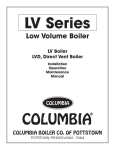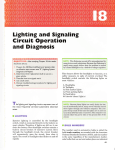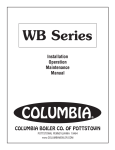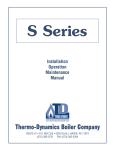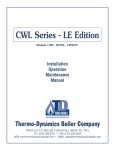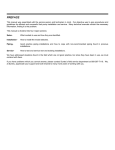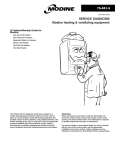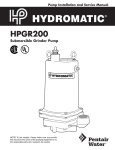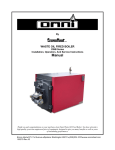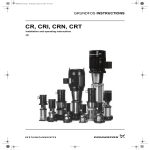Download Columbia EMG-31 140 Operator`s manual
Transcript
INSTALLATION AND OPERATOR’S MANUAL EMERALD SERIES EM-85 THRU EM-200 OIL FIRED PACKAGED BOILER BURNER UNIT COLUMBIA ® COLUMBIA BOILER CO. OF POTTSTOWN POTTSTOWN, PENNSYLVANIA 19464 FL UE BO X Homeowner / Installer Policy We at Columbia Boiler Company would like to “Thank You” for choosing our top of the line Emerald Series Boiler. At Columbia Boiler we take pride in the serviceability and the quality construction of our products. We have built trusting relationships that date back through our company’s history to 1936. We believe that personal service is the best service and our customers agree. We would like to offer you a few helpful service points to insure your family years of trouble free comfort. In order to maintain peak performance of your boiler, it is recommended that your boiler be maintained annually. Servicing of your appliance must be performed by a qualified oil heating technician. A properly trained oil technician will be prepared to set your boiler/burner combination with the proper tools necessary to achieve your maximum comfort and efficiency. As a family owned business, we are happy to have you as one of our many satisfied homeowners who have been choosing Columbia boilers for over 70 years. We look forward to a long and continued relationship. Rosemarie Bartchak Sales and Marketing Manager Columbia Boiler Residential Sales TABLE OF CONTENTS Page Emerald Series Boiler Ratings and Dimensions . . . . . . . . . . . . . . . . . . . . . . . . . . . . . . . . . 1 Installation and Operating Information . . . . . . . . . . . . . . . . . . . . . . . . . . . . . . . . . . . . . . . . 2 Piping Diagram . . . . . . . . . . . . . . . . . . . . . . . . . . . . . . . . . . . . . . . . . . . . . . . . . . . . . . . . . . 6 Trouble Shooting Guide . . . . . . . . . . . . . . . . . . . . . . . . . . . . . . . . . . . . . . . . . . . . . . . . . . . . 7 Wiring Diagrams . . . . . . . . . . . . . . . . . . . . . . . . . . . . . . . . . . . . . . . . . . . . . . . . . . . . . . 12-13 Burner Service Set-Up Records . . . . . . . . . . . . . . . . . . . . . . . . . . . . . . . . . . . . . . . . . . 14-15 Emerald Series Boiler/Burner Unit Specifications . . . . . . . . . . . . . . . . . . . . . . . . . . . . . . . 16 EMERALD PACKAGED, HYDRONIC HEATING BOILERS SERIES IBR/DOE RATINGS AND DATA Boiler Model No. EM-85 Firing Rate -- #2 Fuel Input -- MBTU/Hr. DOE Heating Capacity MBTU/Hr. Net IBR Rating MBTU/Hr. GPM Tankless Coil DIMENSIONS (INCHES) EM-100 EM-3100 EM-110 EM-125 EM-3125 EM-135 EM-150 EM-165 EM-175 EM-200 .85 119 101 88 3 1.00 140 118 103 5 1.00 140 119 103 5 1.10 154 130 113 5 1.25 175 148 129 5 1.25 175 146 127 5 1.35 189 159 138 5 1.50 210 176 153 5 1.65 231 183 168 5 1.75 245 205 178 5 2.00 280 234 203 5 EM-85 EM-100 EM-3100 EM-110 EM-125 EM-3125 EM-135 EM-150 EM-165 EM-175 EM-200 A C D Length Height Width 20" 37-1/4" 19-1/2" 20" 37-1/4" 19-1/2" 21" 46" 21" 20" 37-1/4" 19-1/2" 20" 37-1/4" 19-1/2" 21" 46" 21" 21" 46" 21" 21" 46" 21" 21" 46" 21" 21" 46" 21" 21" 46" 21" E F G Height Diameter Base Hgt. 34-3/8" 16-3/4" 17" 34-3/8" 16-3/4" 17" 43-3/8" 18-3/4" 20-1/2" 34-3/8" 16-3/4" 17" 34-3/8" 16-3/4" 17" 43-3/8" 18-3/4" 20-1/2" 43-3/8" 18-3/4" 20-1/2" 43-3/8" 18-3/4" 20-1/2" 43-3/8" 18-3/4" 20-1/2" 43-3/8" 18-3/4" 20-1/2" 43-3/8" 18-3/4" 20-1/2" Size Height C.L. to Rear 6" 37-1/2" 9" 6" 37-1/2" 9" 6" 47" 10-1/2" 6" 37-1/2" 9" 6" 37-1/2" 9" 6" 47" 10-1/2" 8" 47" 10-1/2" 8" 47" 10-1/2" 8" 47" 10-1/2" 8" 47" 10-1/2" 8" 47" 10-1/2" Size Supply L Height Outlet M C.L. to Outlet 1-1/4" 35-1/4" 9" 1-1/4" 35-1/4" 9" 1-1/4" 45" 8-3/8" 1-1/4" 35-1/4" 9" 1-1/4" 35-1/4" 9" 1-1/4" 45" 8-3/8" 1-1/4" 45" 8-3/8" 1-1/4" 45" 8-3/8" 1-1/4" 45" 8-3/8" 1-1/4" 45" 8-3/8" 1-1/4" 45" 8-3/8" Feed/ Drain Size Height 1-1/4" 19-1/4" 1-1/4" 19-1/4" 1-1/4" 22-3/4" 1-1/4" 19-1/4" 1-1/4" 19-1/4" 1-1/4" 22-3/4" 1-1/4" 22-3/4" 1-1/4" 22-3/4" 1-1/4" 22-3/4" 1-1/4" 22-3/4" 1-1/4" 22-3/4" Return Q Inlet S Size C.L. to Inlet Height 1-1/4" 20" 19" 1-1/4" 20" 19" 1-1/4" 20" 22-1/2" 1-1/4" 20" 19" 1-1/4" 20" 19" 1-1/4" 20" 22-1/2" 1-1/4" 20" 22-1/2" 1-1/4" 20" 22-1/2" 1-1/4" 20" 22-1/2" 1-1/4" 20" 22-1/2" 1-1/4" 20" 22-1/2" Coil Conn. U Nominal Size Height 1/2" 32-1/4" 1/2" 32-1/4" 1/2" 42" 1/2" 32-1/4" 1/2" 32-1/4" 1/2" 42" 1/2" 42" 1/2" 42" 1/2" 42" 1/2" 42" 1/2" 42" Casing Boiler H Flue I Outlet J O COLUMBIA BOILER CO. OF POTTSTOWN BOX G, POTTSTOWN, PA 19464 ASME Construction 1 Emerald Series Installation and Operators Manual COLUMBIA COLUMBIA BOILER CO. OF POTTSTOWN Box G, Pottstown, Pennsylvania 19464 A Message to: Installer, Serviceman, Homeowner: Over sixty years of engineering and product development have gone into your new Columbia oil fired boiler. It’s quality and design are unsurpassed. Properly installed and maintained, it will provide many years of efficient and dependable operation. Please read this Instruction Manual carefully. The information contained within is designed to help you maintain peak performance from your boiler/burner unit. A. Installation Instructions CAUTION: 1. Installer must be a trained, experienced serviceman. 2. Inspect the boiler, jacket and all components to be sure damage has not occurred in shipment. If damage is evident you must file a claim with the freight carrier immediately. 3. Disconnect power supply before connecting wiring. 4. Refer to local installation codes for oil burning equipment, for recommended installation practice. 5. A complete heat loss calculation is necessary to choose the proper size unit to install. The boiler should be sized to within 25% of the actual heat loss of the structure. 6. Conduct thorough checkout when installation is complete. Figure 1. The nuts that secure the tankless coil flange should be tightened before the boiler is filled with water, after initial firing and once a year during the annual maintenance. DETERIORATION DUE TO COIL GASKET LEAKS WILL VOID THE WARRANTY. 1) Place the boiler on a level non-combustible floor, preferably raised and as close to the chimney as possible. The following minimum clearances must be adhered to during installation and maintained thereafter to properly clean, inspect and service your boiler: sides and back - 6"; front - 24" and vent connector - 18". Reduced clearance installations must follow NFPA-31 guidelines. 3a) This style of boiler is equipped with a built in “Air Scoop System.” This feature allows quiet air free operation of your hot water system by assuring the removal of air pockets without the installation of Air Scoops to trap noisy air. 2) For location of piping refer to the installation drawing in Figure 1. The burner, aquastat and circulator are wired at the factory. For power and thermostat (not supplied) wiring connections see the control manuals provided along with this manual. For piping and wiring of other system components see the manufacturers installation manuals. The 1-1/4" supply line or Riser tapping in the top of the boiler extends approximately 1" below the top or waterline of the boiler, thus allowing only air free water to enter the supply to the heating system. The air trapped in the top of the boiler is then purged through a 3/4" vent tapping to be released with an (1) automatic float vent (2) a manual vent or (3) piped into a conventional type expansion tank. 3) The tankless water heater may be piped as shown in Figure 1. A mixing valve, not supplied, must be used to reduce the water temperature at kitchen or bathroom taps. High temperature water for a dishwasher may be obtained by piping as shown in 2 type of installation for these conditions. Manual venting of the fuel unit is usually required on initial start-up. Failure to vent air could result in an air lock/oil starvation condition. (One pipe) Relief valve discharges and drain valve piping should be piped to a safe place of discharge. All plugs and water connections should be checked for leaks upon installation and annually. Fuel supply below the level of burner: Use a single stage fuel unit in lift conditions of up to 10 ft., and a two stage fuel unit when the lift exceeds 10 ft. Both conditions require the use of a return line which helps to purge the fuel unit of air returning it to the fuel tank. The “by-pass” plug must be inserted into the fuel unit when installing a return line. (Two pipe) 4) Be certain the chimney is clean and free of obstructions. Connect boiler flue outlet to chimney using galvanized smoke pipe. The flue pipe should be pitched upward at least 1/4" per foot of run. Refer to Page 1 in this manual for proper size flue pipe for your model boiler. Use only elbows and straight sections. Tees may be used in a straight section in conjunction with a barometric draft regulator; however, they must not be used for a 90° turn. Each joint should be securely fastened with sheet metal screws. The flue pipe must not be inserted beyond the inside wall of the chimney. Install barometric draft regulator in the horizontal or vertical section of the flue pipe. Fuel line installation: Continuous lengths of heavy wall copper tubing are recommended and should be installed under the floor when possible. Always use flare fittings. Always install fittings in accessible locations. Never use teflon tape on any fuel fitting. Use of teflon will void any pump warranty. Fuel lines should not run against the appliance or the ceiling joists. 5) The boiler room must be well ventilated to allow sufficient make-up air to support combustion. Lack of adequate combustion air may result in erratic operation of the burner, noisy combustion or fuel odors. Remember your need for outside air will be greatly increased if you have a vented dryer in the basement or other venting fans in the home. Boilers located in confined spaces shall be provided with two permanent openings, one near the top and one near the bottom of the enclosure. Each opening shall have a free area of not less than one square inch per 1000 BTU per hour input rating of the boiler, freely communicating with interior areas having adequate infiltration from the outside. Fuel line valve and filter: Install two high quality shutoff valve(s) in accessible locations on the oil supply line. Locate one close to the tank and the other close to the burner ahead of the filter. Some filters come with built-in shutoff valves. Install a generous capacity filter inside the building between the fuel tank shutoff valve and the burner locating both the filter and the valve close to the burner for ease of servicing. Always use flare fittings. Never use compression fittings. IMPORTANT All oil feed lines to burners must be air tight. Use only flare fittings when assembling oil lines since the slightest air leak, caused by loose fittings, bad gaskets or any other reason, can cause a foaming oil stream which will cause any of the following conditions: 6) Fill boiler and system with water. Be sure entire system has been purged of air and the desired pressure is obtained. a) Intermittent firing, causing safety shutdown 7) Connect burner to oil supply. Refer to fuel unit manufacturer literature for piping, connections, lift and tank installation. If such information is unavailable use the following guidelines. b) Poor starts c) Smokey starts d) Continual sooting of boiler and burner parts including the cad cell FUEL UNITS/FUEL LINES e) Reduced firing rate, inefficient operation and erratic fire pattern Fuel supply “level with” or “above” burner: A single stage fuel unit connected to the fuel supply with a single supply line is the most common 3 temperature is normally maintained at 160°F around the tankless coil by the operating control so that an abundance of hot water is available. If the boiler water temperature should fall below the operating control setting (160°F) the oil burner will be started again by that control (and the circulating pump will be prevented from operating) until the operating control setting is satisfied. See control manufacturers literature included in the data package for detailed wiring, operating and safety instructions. f) A dangerous combustion condition, allowing the firebox to fill with a lean mixture (too much air in the oil stream) which could cause a delay in ignition of the fuel mixture until the danger point has been reached. Suction vacuum must be held to acceptable limits. The vacuum test is worth the time required to make it. This problem becomes proportionately larger with underground tanks. If the following procedures are followed, burner related problems will be minimized: a) Connect vacuum gauge to oil pump. Suction vacuum must not exceed 10 inches of mercury for single stage pumps and 15 inches for two stage pumps. It is preferable to stay below these limitations. 2) Boilers Less Tankless Coil - This boiler is equipped with a high limit aquastat control which should be set at 180° by the installer. The oil burner is operated in an identical sequence as 1), except that the boiler water temperature need not be maintained at a 160°F low limit setting since there is no domestic hot water load to protect. See control manufacturers literature included in the data package for detailed wiring, operating and safety instructions. b) When the suction line is tight and properly installed the pump will hold its vacuum for a minimum of 60 minutes after shutdown. c) Installation of a check valve in the suction line of a two pipe system is advisable under all circumstances. Be sure the check valve fittings are airtight. 3) A cadmium sulfide flame scanner (cad cell) and relay are provided with the oil burner. The cad cell will stop the oil burner within a predetermined number of seconds if the fuel fails to ignite or if the flame goes out during operation. The oil burner will remain off until the red reset button on the relay has been pushed. RESET MUST NEVER BE PRESSED MORE THAN ONCE DURING A SINGLE FLAME FAILURE. d) Connect the electric supply to the boiler as indicated on the wiring diagrams. The wiring must be installed in accordance with the National Electrical Code and any other state and local codes. C. Operational Sequence 1) Boilers with Tankless Coil - This boiler is equipped with a combination aquastat control which has high and low limits to be set at 180° and 160° respectively by the installer. When room temperature falls below thermostat setting, thermostat calls for heat starting the burner and circulating pump. The burner and pump continue to operate until room heating requirements are satisfied (thermostat setting is reached), or until boiler water temperature reaches the high limit control temperature setting. If the high limit control temperature setting is reached, the burner shuts off and the circulating pump continues to operate until the room heating requirements are satisfied. If the thermostat continues to call for heat after the boiler water temperature has dropped below the temperature setting of the high limit control, the oil burner will start again, while the circulating pump will continue to run. The boiler water D. Start-Up and Check-Out Procedure CAUTION Only a trained, experienced serviceman should attempt the checkout procedure outlined below. Read the burner manufacturers instructions for start-up for special instructions and special features of the burner and control. 1) Combustion test equipment required for proper burner adjustment: a) b) c) d) e) f) 4 CO2 Analyzer Draft Gauge Oil Pressure Gauge 0-200 PSI Stack Thermometer Smoke Test Gun Vacuum Gauge 0-30 in. of Hg ter so that the CO2 measured in the stack ahead of the draft control should be a minimum of 10% and a maximum of 12%. At the same time the draft should be adjusted to .01"-.02" W.C. over the fire. Install a second barometric draft control if necessary to reduce excessive draft. The smoke should also be checked with a smoke gun and found to be zero. 2) In order to take flue gas samples for combustion testing a 1/4" hole must be drilled in the flue pipe between the boiler and the barometric draft regulator. 3) Open all shut-off valves in the oil supply line to the burner. 4) Set thermostats substantially above room temperature. 11) Check operation of the cad cell relay by removing one cad cell wire from external terminal during the flame cycle. The relay should cut the burner off in approximately 15 to 45 seconds, depending on the control provided. See the burner manufacturers manual provided in the data pack. 5) Check electrode settings and readjust air setting if required. Electrode settings are shown in the burner manual provided along with this manual. Burner settings are listed on the Service Man’s Label attached to the boiler and on the Burner Unit specifications provided along with this manual. E. Servicing the Boiler/Burner Unit 6) Install pressure gauge in the 1/8" gauge port of the oil pump. 1) Burner Components: If replacement of burner parts is necessary, always use parts recommended by the manufacturer. Specify part number and description when ordering. 7) Turn on switch to start burner. If burner does not start immediately, you may need to reset the burner control. See the burner manufac turers instructions for control and reset features. 2) Electrode settings are important for reliable ignition of the oil. Check to be sure the settings are in accordance with the instructions provided in the burner manual. 8) On one pipe systems bleed the oil pump as soon as burner motor starts. To bleed, attach a length of 1/4" O.D. clear plastic tubing to the end of the bleed plug and then loosen plug while holding an empty container under the tubing to catch all of the expelled oil. Bleed for at least 15 seconds after the oil stream is free of all air. If air is still evident in the bleed line you must check the oil lines, all fittings, filters and any other connections for tightness. Kinks in the oil lines will create undue high vacuum therefore they must be eliminated. When you are sure all air has been eliminated then close the bleed valve. Ignition should be instantaneous following the closing of this valve. If it is not, proceed to the trouble shooting guide to determine why the oil did not ignite. 3) Nozzles: The nozzle specifications listed in the manual are the result of years of exhaustive engineering testing. ANY NOZZLE REPLACEMENT SHOULD BE OF THE EXACT TYPE AS LISTED IN THE SPECIFICATIONS. Use extreme care in handling nozzles to avoid scratches or dirt that could cause leaks or affect the oil spray pattern. 4) Fan and blower housing should be kept clean of dirt and lint. If heating unit is located near an unvented dryer, special care must be taken so that lint does not clog the burner air inlets. 5) Replace the oil filter cartridge annually. 6) Cleaning the Boiler: Cleaning should be done only by a trained, experienced serviceman. Turn power off to the boiler. To clean the boiler, remove the flue pipe, jacket top and flue collector. Remove the baffles then clean the tubes with a soft 2" flue brush. Reinstall parts, readjust and clean the burner if required.” 9) Be sure the oil pump discharge pressure is adjusted to 140 PSI. If it is not refer to the oil pump manufacturer’s instruction sheet for pressure adjustment procedure. 10) FINAL ADJUSTMENTS OF THE BURNER MUST BE MADE USING PROPER COMBUSTION TEST EQUIPMENT. The air supply should be adjusted by loosening the lock screw and moving the bulk air band or shut5 FIGURE 1 6 Troubleshooting Guide TROUBLE: BURNER DOES NOT START SOURCE PROCEDURE CAUSES REMEDY Power Check boiler disconnect and main disconnect switch Switch open. Close switch. Tripped breaker or blown fuse Reset breaker or replace fuse Thermostat set too low. Thermostat on “off” or “cool” Thermostat not level Turn up thermostat Switch to heat Level thermostat Open thermostat wires Repair or replace wires Loose thermostat connectors Faulty thermostat Tighten connection Replace thermostat Check burner motor overload switch, if equipped Check primary control safety switch. Burner motor tripped on overload Primary tripped on safety Press reset button Press reset button Check limit settings versus boiler water temperature Check for voltage at L1 and L2 Jump TT terminals on aquastat then check for voltage at terminals B1 and B2 Burner off on limit Adjust limit settings Open safety switch, tripped breaker or blown fuse No voltage indicates defective control Close switch, reset breaker or replace fuse Replace control Check for voltage between the black and white leads. No voltage indicates no power to the control. Make sure the the jumper on TT terminals is installed Aquastat limit control switch open Check limit setting. Open circuit between limit control and primary control if voltage is present at B1 and B2 of aquastat Repair circuit. Check for voltage burner motor. Voltage indicates power to motor and a fault in the burner. Pump seized. Turn off power to burner. Rotate blower by hand, check for excessive drag. Replace fuel unit or blower wheel. Replace burner motor Thermostat Check thermostat settings Jump TT terminals on aquastat control. If burner starts, fault is in the thermostat circuit Circuit Resets Aquastat Control Primary Control Burner Blower wheel binding Burner motor defective 7 TROUBLE: BURNER STARTS BUT DOES NOT ESTABLISH FLAME SOURCE PROCEDURE CAUSES REMEDY Oil Supply Check tank for oil Check for water in oil tank using a dip stick coated with litmus paste Listen for pump whine. Empty tank. Water in oil tank Fill tank. Strip tank of water Fuel supply valve closed Oil filter plugged Plugged pump strainer Restriction in oil line Air leak in fuel system Open valve Replace filter cartridge Clean strainer Repair oil line Repair leak. The use of flare fittings is strongly recommended. Do not use Teflon tape on oil fittings Pump discharge pressure set too low Set pressure at 140 PSI Coupling worn or broken Pump worn - low pressure motor overloads Replace coupling Replace pump Combustion Check air shutter and Air air band Requirements Improper air adjustment Adjust air as indicated in manual. Set CO2 to 10% min - 12% max with zero smoke Ignition Electrodes Incorrect electrode settings eroded electrode tips Carboned and shorted electrodes Cracked porcelain insulators Dress up tips and reset electrodes Clean electrodes Open pump bleed port and start burner. Milky oil or no oil indicates loss of prime Oil Pump Install pressure gauge in port of fuel pump. Pressure should be 140 PSI Remove and inspect nozzle line assembly Replace electrodes Nozzle Inspect nozzle for plugged orifice and distributor slots Inspect nozzle for correct size and specifications Plugged orifice or distributor or strainer Incorrect nozzle installed Replace nozzle with nozzle specified in this manual and on the boiler lower jacket panel Ignitor Connect ignitor leads to line voltage. Listen for spark. Check that ignitor terminals are not arcing with buss bars. No spark or weak spark Replace ignitor 8 TROUBLE: BURNER FIRES, BUT THEN FAILS ON SAFETY SOURCE PROCEDURE CAUSES REMEDY Cad Cell Check cad cell with ohmmeter. If more than 1500 ohms, cad cell is defective or dirty Faulty or dirty cad cell Clean or replace cad cell Primary Control See Control Manual Faulty primary control Replace primary control Poor Fire Inspect flame for stability Wrong nozzle Replace nozzle with type specified Adjust draft to -.01-.02 W.C. overfire Adjust air for a CO2 of 10% min. to 12% max. and zero smoke Repair leaky fittings Improper draft Improper air adjustment Air in oil supply Oil Supply If burner loses flame prior to the primary control locking out, fault is in the fuel system Air leak to fuel system Restriction in oil line Plugged fuel filter Plugged pump strainer Cold oil Repair leak. The use of flare fittings is recommended. Clear oil line restriction. Replace filter cartridge. Clean strainer use #1 heating oil or additive to thin oil Pump Install pressure gauge in gauge port of oil pump Pressure should be 140 PSI Pump discharge pressure incorrectly set Coupling worn or broken Pump worn Set pressure at 140 PSI Burner motor overloads. Turn off power and rotate blower by hand to check for excessive drag Pump or blower overloading motor Replace blower or pump Faulty motor Replace motor Burner Motor Replace coupling Replace pump TROUBLE: HIGH NET STACK TEMPERATURES SOURCE PROCEDURE CAUSES REMEDY Nozzle Inspect nozzle for correct size and type Check pump pressure with pump gauge Incorrect nozzle Nozzle overfiring due to high pump pressure Replace nozzle with nozzle specified Reduce pump pressure to 140 PSI Heat exchanger fouled Clean heat exchanger Heat Exchanger Check heat exchanger surfaces for soot or scale fouling 9 TROUBLE: BURNER FIRES BUT PULSATES SOURCE PROCEDURE CAUSES REMEDY Draft Take a draft reading. Draft should be -.01"-.02" W.C. overfire Insufficient draft Increase draft setting. Be sure chimney is clean and meets the minimum size requirements. Reduce draft settings. Install second draft regulator if necessary Excessive draft Draft Regulator Inspect draft regulator for correct location Improper installation Move draft regulator to correct location Combustion Air Inspect installation for adequate incoming make-up air Adjust combustion air and take a CO2 reading Insufficient amount of make-up air in boiler room Provide openings that freely communicate with outside. Improper air intake adjustment Adjust CO2 level to 10% min. 12% max. and zero smoke Oil Supply Bleed pump and inspect for air Air leak in fuel system Repair air leak Use flare fittings only Pump Pressure Install pressure gauge in port of oil pump. Pressure should be 140 PSI Pump discharge pressure incorrectly set Set pressure at 140 PSI Coupling worn or broken Replace coupling Plugged orifice or distributor Plugged nozzle strainer Replace nozzle with correct nozzle as specified Nozzle Inspect nozzle for plugged orifice and distributor slots TROUBLE: TOO MUCH HEAT SOURCE PROCEDURE CAUSES REMEDY Circulator Check to see if operating control is working properly Circulator does not stop running Repair operating control Thermostat Check thermostat settings and calibration Thermostat set too high Reset thermostat Thermostat defective Thermostat out of calibration Replace thermostat. Recalibrate. Flow valve/zone valve dirty and stuck Replace zone valve Replace flow valve Flow or Zone Valve Check to see if flow valve/ zone valve is operating properly 10 TROUBLE: INSUFFICIENT HEAT SOURCE PROCEDURE CAUSES REMEDY Circulator Check if circulator is operational. Pump binding Replace pump Circulator motor burned out Wiring from operating control defective Operating control defective Replace circulator motor Repair wiring Check thermostat settings Settings too low Increase setting Check thermostat location Bad location due to heat build up Out of calibration Move thermostat to a better location Recalibrate Thermostat Check thermostat calibration Repair or replace operating control Flow Valve/ Zone Valve Check flow valve/zone valve for sticking in partially closed position Flow valve/zone valve not opening fully Clean or replace flow valve/zone valve Radiation Check for air in radiators Check to see if radiators are sized properly Radiators airbound Radiators inadequate Bleed radiators Install adequate radiation Tankless Coil Check usage of domestic hot water Demand too large Install flow regulator Additional boiler capacity required Heat Exchanger Check heat exchanger for soot or scale accumulation Insufficient heat transfer Clean heat exchanger Burner Check pump pressure with pressure gauge Insufficient pump pressure Increase pressure to 140 PSI Nozzle Check nozzle for size and spray angle Check nozzle for plugged orifice, scoured surface Wrong nozzle installed Install specified nozzle Nozzle underfiring due to defective nozzle Replace nozzle TROUBLE: INSUFFICIENT DOMESTIC HOT WATER SOURCE PROCEDURE CAUSES REMEDY Tankless Coil Analyze capacity vs. usage Check coil for fouling Insufficient coil capacity Hard water scaling Install larger coil Install soft water system Clean coil Operating Control Check operating control setting Setting too low Set operating control low limit to 160°F Heat Exchanger Inspect coils for fouled surfaces and/or flow restrictions Flow restriction Remove restriction Fouled surfaces or heat exchanger Clean heat exchanger surfaces 11 12 (APPLIES TO CARLIN CHIMNEY VENT AND RIELLO CHIMNEY VENT BURNERS) ELECTRICAL DIAGRAM FOR EM SERIES BOILERS TO CONNECT BURNER TO AQUASTAT 13 (APPLIES TO BECKETT CHIMNEY VENT BURNERS) ELECTRICAL DIAGRAM FOR EM SERIES BOILERS TO CONNECT BURNER TO AQUASTAT BURNER SERVICE SET-UP RECORDS 1 2 1. Date 2. Model Number 3. Firing Rate 4. Pump Pressure* 5. CO2 6. “0” Smoke 7. Gross Stack°F 8. Draft Over Fire 9. Replaced Filter Yes/No 10. Replaced Nozzle Yes/No 11. Clean Pump Filter Yes/No 12. Inspect Coil Gasket 13. Check for Leaks @ plugs/fittings 14. Brush Clean Flue Tube Passages 15. Vacuum Chamber/Flue Tubes 16. Clean Blower Wheel 17. Check/Set Electrodes 14 3 4 5 BURNER SERVICE SET-UP RECORDS 6 7 1. Date 2. Model Number 3. Firing Rate 4. Pump Pressure* 5. CO2 6. “0” Smoke 7. Gross Stack°F 8. Draft Over Fire 9. Replaced Filter Yes/No 10. Replaced Nozzle Yes/No 11. Clean Pump Filter Yes/No 12. Inspect Coil Gasket 13. Check for Leaks @ plugs/fittings 14. Brush Clean Flue Tube Passages 15. Vacuum Chamber/Flue Tubes 16. Clean Blower Wheel 17. Check/Set Electrodes 15 8 9 10 Columbia Emerald Boiler/Burner Unit Specifications BOILER/BURNER UNIT SPECIFICATIONS - BECKETT AFG Pump Boiler Model Pressure PSI Burner Hd. Delavan Nozzle EM - 85 EM-100 EM-3100 EM-110 EM-3125 EM-125 EM-135 EM-150 EM-165 EM-175 EM-200 140 140 140 140 140 140 140 140 140 140 140 F-3 F-3 F-3 F-6 F-6 F-6 F-6 F-12 F-12 F-12 F-22 .65 80°B .75 80°B .85 80°B .85 80°B 1.00 80°B 1.00 80°B 1.10 80°A 1.25 80°A 1.35 80°A 1.50 80°A 1.65 80°A Approximate Air Setting Shutter Band 8 10 10 10 10 10 10 9 10 10 10 0 0 0 0 2 2 2 0 0 1 2 BOILER/BURNER UNIT SPECIFICATIONS - RIELLO 5F BURNER Boiler Model Pump Pressure PSI Delavan Nozzle Approximate Air Setting Band EM - 85 EM-100 EM-110 EM-125 EM-135 EM-150 EM-165 EM-175 EM-200 150 150 150 150 150 150 150 150 150 .65 60°A .75 60°A .85 60°A 1.00 60°A 1.10 80°A 1.25 80°A 1.35 80°A 1.50 80°A 1.65 80°B 1.75 1.75 2.25 2.75 3.25 3.8 2.0 2.8 2.75 BOILER/BURNER UNIT SPECIFICATIONS - CARLIN EZ-1 BURNER Boiler Model Pump Pressure PSI Delavan Nozzle Approximate Air Setting Band EM - 85 EM-100 EM-110 EM-125 EM-135 EM-150 EM-165 EM-175 EM-200 140 140 140 140 140 140 140 140 140 .65 70°A .75 70°A .85 70°A 1.00 60°B 1.10 60°B 1.25 60°B 1.35 60°B 1.50 70°A 1.65 70°A .65 .65 .75 .85 .90 1.25 1.35 2.00 2.00 Notice: All settings are approximate. Check the Installer Serviceman Label on the boiler for updates and use instruments to make final settings in accordance with the procedure in this manual. 16 OIL BURNER BECKETT AFG BURNER (PART NO. 540120) CARLIN EZ-1 BURNER (PART NO. 542210) RIELLO F-5 BURNER (PART NO. 541152) NOTES: 1. KNOCKDOWN BOILERS SUPPLIED WITH THREE (3) PIECE SIDE/REAR JACKET. 2. BASE ASSEMBLY FOR UNITS PRODUCED PRIOR TO 1999 CONSISTING OF BASE, CHAMBER WRAPPER, FRONT PANEL, PEEP SIGHT, CHAMBER SUPPORT BLOCK AND FIRE CHAMBER (PART NO. 790416). 3. BASE ASSEMBLY FOR UNITS PRODUCED AFTER 1999 CONSISTING OF BASE, CHAMBER WRAPPER, FRONT PANEL, PEEP SIGHT, CHAMBER SUPPORT BLOCK AND FIRE CHAMBER (PART NO. 790415). CC-7821 CBC P/N 595850 10/08 - 500




















